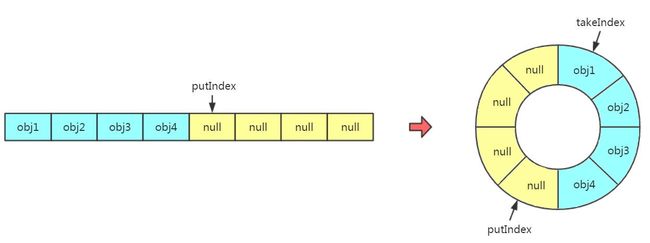Java8 - ArrayBlockingQueue源码
一、概述
ArrayBlockingQueue 是一个基于循环数组的有界阻塞队列,一旦创建了队列,那么其容量就不能再改变了,它不允许 null 值的插入。它是通过使用 ReentrantLock 来保证线程安全。
ArrayBlockingQueue 支持对生产者线程和消费者线程进行公平的调度,默认情况下是不保证公平性的。公平性通常会降低吞吐量,但是可以减少了可变性和避免了线程饥饿。
二、循环数组
PS:接触过循环数组这种数据结构的,可以直接跳过这一小节。
通常,队列的实现方式有数组和链表两种方式。对于数组这种实现方式来说,我们可以通过维护一个队尾指针,使得在入队的时候可以在O(1)的时间内完成;但是对于出队操作,在删除队头元素之后,必须将数组中的所有元素都往前移动一个位置,这个操作的复杂度达到了O(n),效果并不是很好。如下图所示:
为了解决这个问题,我们可以使用另外一种逻辑结构来处理数组中各个位置之间的关系。假设现在我们有一个数组A[1…n],我们可以把它想象成一个环型结构,即A[n]之后是A[1],如下图所示:那么我们便可以使用两个指针,分别维护队头和队尾两个位置,使入队和出队操作都可以在O(1)的时间内完成,如下图所示。当然,这个环形结构只是逻辑上的结构,实际的物理结构还是一个普通的数据。
到此,我们对 ArrayBlockingQueue 使用的数据结构有了一定的了解,那么接下来我们就来看看它是怎么实现的。
三、属性
//队列的底层结构
final Object[] items;
//队头指针
int takeIndex;
//队尾指针
int putIndex;
//队列中的元素个数
int count;
final ReentrantLock lock;
//并发时的两种状态
private final Condition notEmpty;
private final Condition notFull;四、方法
1、基本方法
下面的代码是入队和出队操作的实现,我们可以看到,putIndex 指向的是下一个插入的位置,而 takeIndex 指向的是队头元素的位置,如下图,通过这两个指针,我们就可以在 O(1) 的时间内完成入队和出队操作。
//入队
private void enqueue(E x) {
// assert lock.getHoldCount() == 1;
// assert items[putIndex] == null;
final Object[] items = this.items;
items[putIndex] = x;
if (++putIndex == items.length)
putIndex = 0;
count++;
//唤醒
notEmpty.signal();
}//出队
private E dequeue() {
// assert lock.getHoldCount() == 1;
// assert items[takeIndex] != null;
final Object[] items = this.items;
@SuppressWarnings("unchecked")
E x = (E) items[takeIndex];
items[takeIndex] = null;
if (++takeIndex == items.length)
takeIndex = 0;
count--;
if (itrs != null)
itrs.elementDequeued();
//唤醒
notFull.signal();
return x;
}
除了入队和出队操作之外,基本操作中还包含删除指定下标元素的操作,从代码中我们可以看到,删除指定下标的元素之后,必须把后面的元素都往前移动,所以这个操作的代价是非常高的。
//删除指定下标的元素
void removeAt(final int removeIndex) {
// assert lock.getHoldCount() == 1;
// assert items[removeIndex] != null;
// assert removeIndex >= 0 && removeIndex < items.length;
final Object[] items = this.items;
if (removeIndex == takeIndex) {
// removing front item; just advance
items[takeIndex] = null;
if (++takeIndex == items.length)
takeIndex = 0;
count--;
if (itrs != null)
itrs.elementDequeued();
} else {
// an "interior" remove
// slide over all others up through putIndex.
final int putIndex = this.putIndex;
for (int i = removeIndex;;) {
int next = i + 1;
if (next == items.length)
next = 0;
if (next != putIndex) {
items[i] = items[next];
i = next;
} else {
items[i] = null;
this.putIndex = i;
break;
}
}
count--;
if (itrs != null)
itrs.removedAt(removeIndex);
}
notFull.signal();
}
2、入队操作
ArrayBlockingQueue 提供了多种入队操作的实现来满足不同情况下的需求,入队操作有如下几种:
public boolean add(E e);
public void put(E e) throws InterruptedException;
public boolean offer(E e);
public boolean offer(E e, long timeout, TimeUnit unit) throws InterruptedException;下面是几种入队操作的具体实现,从源码中我们可以发现,这几种入队操作都直接或间接地调用了enqueue方法,所以只要搞清楚了enqueue方法,就已经没有什么难点了。这几种入队操作的区别如下:
- add(E e):入队成功返回true,入队失败抛出 IllegalStateException 异常。
- put(E e):如果队列满了,会一直等待,直到成功入队。
- offer(E e):入队成功返回true,入队失败返回false。
- offer(E e, long timeout, TimeUnit unit):在指定的时间内一直尝试入队,入队成功返回true,超时返回false。
public boolean add(E e) {
return super.add(e);
}
//super.add(e)
public boolean add(E e) {
if (offer(e))
return true;
else
throw new IllegalStateException("Queue full");
}
public boolean offer(E e) {
checkNotNull(e);
final ReentrantLock lock = this.lock;
lock.lock();
try {
if (count == items.length)
return false;
else {
enqueue(e);
return true;
}
} finally {
lock.unlock();
}
}
public void put(E e) throws InterruptedException {
checkNotNull(e);
final ReentrantLock lock = this.lock;
lock.lockInterruptibly();
try {
//如果队列满了,则进行等待并释放锁,等待入队操作来唤醒
while (count == items.length)
notFull.await();
enqueue(e);
} finally {
lock.unlock();
}
}
public boolean offer(E e, long timeout, TimeUnit unit) throws InterruptedException {
checkNotNull(e);
long nanos = unit.toNanos(timeout);
final ReentrantLock lock = this.lock;
lock.lockInterruptibly();
try {
while (count == items.length) {
if (nanos <= 0)
return false;
nanos = notFull.awaitNanos(nanos);
}
enqueue(e);
return true;
} finally {
lock.unlock();
}
}3、出队操作
同时,ArrayBlockingQueue 也提供了多种出队操作的实现来满足不同情况下的需求,如下:
public E poll();
public E poll(long timeout, TimeUnit unit) throws InterruptedException;
public E take() throws InterruptedException;下面是几种出队操作的具体实现,与入队操作类似,这几种出队操作都直接或间接地调用了dequeue方法,所以如果搞清楚了前面的dequeue方法,就已经没有什么难点了。这几种出队操作的区别如下:
- take():如果队列为空,就一直等待,直到出队成功,并返回队头元素。
- poll():如果队列不为空,则出队并返回队头元素,否则返回null。
- poll(long timeout, TimeUnit unit):在指定的时间内一直尝试出队,出队成功返回队头元素,否则返回null。
public E poll() {
final ReentrantLock lock = this.lock;
lock.lock();
try {
return (count == 0) ? null : dequeue();
} finally {
lock.unlock();
}
}
public E take() throws InterruptedException {
final ReentrantLock lock = this.lock;
lock.lockInterruptibly();
try {
//如果队列为空,则进行等待并释放锁,等待出队操作来唤醒
while (count == 0)
notEmpty.await();
return dequeue();
} finally {
lock.unlock();
}
}
public E poll(long timeout, TimeUnit unit) throws InterruptedException {
long nanos = unit.toNanos(timeout);
final ReentrantLock lock = this.lock;
lock.lockInterruptibly();
try {
while (count == 0) {
if (nanos <= 0)
return null;
nanos = notEmpty.awaitNanos(nanos);
}
return dequeue();
} finally {
lock.unlock();
}
}
4、其他方法
//只获取队头元素,不出队
public E peek() {
final ReentrantLock lock = this.lock;
lock.lock();
try {
//直接通过队头的下标获取队头元素
return itemAt(takeIndex); // null when queue is empty
} finally {
lock.unlock();
}
}
final E itemAt(int i) {
return (E) items[i];
}//获取队列中元素的个数
public int size() {
final ReentrantLock lock = this.lock;
lock.lock();
try {
return count;
} finally {
lock.unlock();
}
}//获取队列中剩余的存储空间
public int remainingCapacity() {
final ReentrantLock lock = this.lock;
lock.lock();
try {
//数组长度 - 队列中元素个数
return items.length - count;
} finally {
lock.unlock();
}
}//从队列中删除指定的对象
//删除操作会遍历整个数组,所以复杂度为O(n)
public boolean remove(Object o) {
if (o == null) return false;
final Object[] items = this.items;
final ReentrantLock lock = this.lock;
lock.lock();
try {
if (count > 0) {
final int putIndex = this.putIndex;
int i = takeIndex;
do {
if (o.equals(items[i])) {
removeAt(i);
return true;
}
if (++i == items.length)
i = 0;
} while (i != putIndex);
}
return false;
} finally {
lock.unlock();
}
}//判断队列中是否存在该元素
//该操作会遍历整个数组,所以复杂度为O(n)
public boolean contains(Object o) {
if (o == null) return false;
final Object[] items = this.items;
final ReentrantLock lock = this.lock;
lock.lock();
try {
if (count > 0) {
final int putIndex = this.putIndex;
int i = takeIndex;
do {
if (o.equals(items[i]))
return true;
if (++i == items.length)
i = 0;
} while (i != putIndex);
}
return false;
} finally {
lock.unlock();
}
}//清空队列中的元素
//复杂度为O(n)
public void clear() {
final Object[] items = this.items;
final ReentrantLock lock = this.lock;
lock.lock();
try {
int k = count;
if (k > 0) {
final int putIndex = this.putIndex;
int i = takeIndex;
do {
items[i] = null;
if (++i == items.length)
i = 0;
} while (i != putIndex);
takeIndex = putIndex;
count = 0;
if (itrs != null)
itrs.queueIsEmpty();
for (; k > 0 && lock.hasWaiters(notFull); k--)
notFull.signal();
}
} finally {
lock.unlock();
}
}
